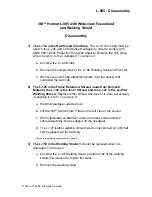
Instrument an
d
control functions
5-13
5
TIP
The ABS performs a self-diagnos-
tic test each time the vehicle first
starts off after the main switch is
turned to “ON” and the vehicle has
traveled at a speed of 10 km/h (6
mi/h) or higher. During this test, a
“clicking” noise can be heard from
the front of the vehicle, and if ei-
ther brake lever is even slightly ap-
plied, a vibration can be felt at the
lever, but these do not indicate a
malfunction.
This ABS has a test mode which
allows the owner to experience
the pulsation at the brake levers
when the ABS is operating. How-
ever, special tools are required, so
please consult your Yamaha deal-
er.
NOTICE
ECA20100
Be careful not to
d
ama
g
e the wheel
sensor or wheel sensor rotor; other-
wise, improper performance of the
ABS will result.
EAU78614
Traction control system
The traction control system helps
maintain traction when accelerating on
slippery surfaces, such as unpaved or
wet roads. If sensors detect that the
rear wheel is starting to slip (uncon-
trolled spinning), the traction control
system assists by regulating engine
power until traction is restored.
When traction control has engaged,
the “
” indicator light will flash. You
may notice changes in engine re-
sponse or exhaust sound.
WARNING
EWA18860
The traction control system is not a
su
b
stitute for ri
d
in
g
appropriately
for the con
d
itions. Traction control
cannot prevent loss of traction
d
ue
to excessive spee
d
when enterin
g
turns, when acceleratin
g
har
d
at a
sharp lean an
g
le, or while
b
rakin
g
,
an
d
cannot prevent front wheel slip-
pin
g
. As with any vehicle, approach
surfaces that may
b
e slippery with
caution an
d
avoi
d
especially slip-
pery surfaces.
1. Front wheel sensor
2. Front wheel sensor rotor
1. Rear wheel sensor
2. Rear wheel sensor rotor
2
1
2
1
UB5X10E0.book Page 13 Thursday, May 27, 2021 8:55 AM
















































